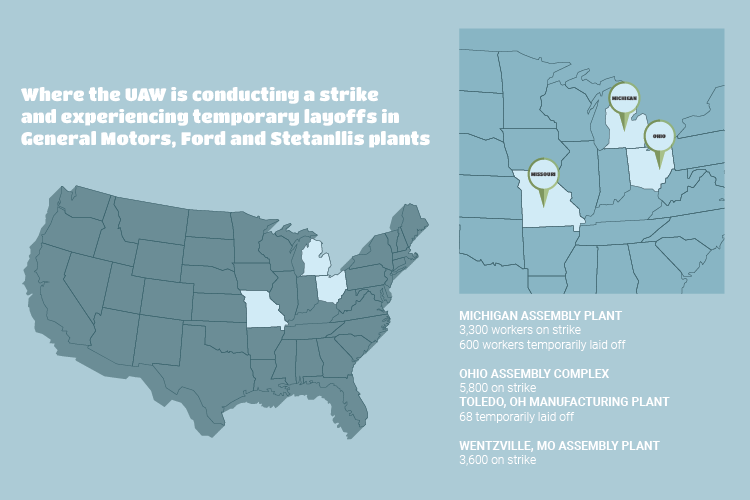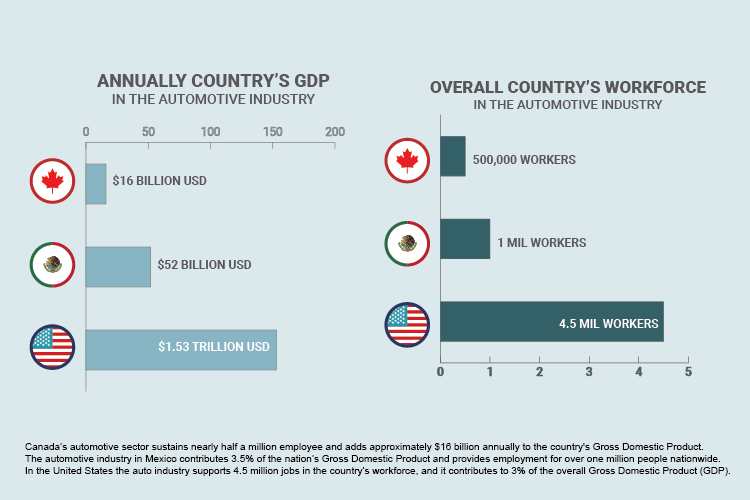How the UAW historic strike will impact supply chains in North America?
The recent United Auto Workers (UAW) is generating an impact in the trucking industry. The UAW’s push for improved workers’ benefits and pointing out differences in pay. On the other hand, major auto companies maintain they have made fair offers, but negotiations have been suspended. This strike’s consequences are notably felt in the trucking sector, vital for transporting auto components. Supply chain disruptions might decrease car parts transportation demand and cause truck driver shortages. With the automotive industry facing high production needs this strike becomes a pressing concern.
What is the role of UAW?
The United Auto Workers (UAW), fully named International Union, United Automobile, Aerospace, and Agricultural Implement Workers of America, is a big and diverse union in North America, covering various job sectors. They have over 400,000 active members and 580,000 retired members in the United States, Canada, and Puerto Rico.
The UAW was founded in 1935, and since then they’ve tried to make things better for their members by achieving a lot through negotiations. They were the first to have employer-paid health insurance and cost-of-living allowances for industrial workers. They have contributed to product quality, job security, and offered training and educational programs.
What is UAW striking for?
UAW workers are striking because they claim their current pay is not enough to support their families or secure their future. The strike was initiated Friday, September 15th at midnight, after the union members and the three major industry automakers: Ford, General Motors, and Stellantis could not agree to new contracts.
The foundation the union had over this deal was that full-time workers earn around $18 – $32 per hour while the CEOs of these big companies together earned a total of $20 million just last year. These figures were the reason for the union to call for higher salaries. Asking to increase wages by 36% over four years.
On the opposing side, we find the automobile companies — Ford, General Motors and Stellantis — who claim they have presented favorable proposals and generous offers to their union workers. However, they keep constantly declining those offers and emphasizing there are boundaries to what they have put forward. For instance, in September 2019, General Motors gave its UAW employees an offer that established they would have to pay 15% of their healthcare costs when the average U.S. worker is 28%. The UAW workers were unwilling to accept the initial General Motors offer and they had to back down to 3% of the cost.
How is the automotive supply chain in North America being affected by the current events?
The UAW strike could have significant repercussions across multiple sectors, mainly affecting the trucking industry. Given the automotive industry’s substantial dependence on the trucking sector for the transportation of vital automotive components and assemblies, any disruption in the supply chain may trigger consequences for the trucking sector. This means there might be some potential reduction in the demand for transporting car parts as well as a shortage of truck drivers. This may affect how much money the trucking companies make and how many people they can employ.
As for right now, we are experiencing a historically high demand for automotive production, which means if this strike keeps going the trucking industry would be severely affected. According to Armando Cortés, general director of the National Auto Parts Industry (INA)
“Last May, auto parts production reached an all-time high for auto parts manufacturing in Mexico. The value of the auto parts industry grew 26% compared to pre-pandemic levels and about 21% compared to the same period in 2022”
In terms of production, the North American region is projected to close 2023 with a production estimated value of 450 billion USD, representing a 6.2% increase compared to the previous year.
Due to the ongoing strike, the ‘big three’ automakers are beginning to experience order cancellations from their suppliers. This is creating disruptions in the entire automotive supply chain. While suppliers can continue building auto parts even if the orders are canceled, the customers —companies affected by the strike—may refuse to accept deliveries. Suppliers will have to explore alternative options, such as storing those parts, but this will only incur additional expenses. Consequently, the demand for these parts is going to drop or stop altogether. This implies that even after the strike is over, the automotive supply chain will likely be dealing with the aftermath.
Knowing this information, now, more than ever automotive companies need freight forwarder services throughout North America. We, as a freight transportation company, might be experiencing collateral damage due to the ongoing strike happening in the US and Canada. Nonetheless, the importance of freight forwarding services within the automotive sector has a favorable impact, particularly in terms of enabling crucial package-sending and tracking capabilities for manufacturers. To ensure effective planning and seamless execution of the transportation process for auto parts and vehicles, an automotive company must certainly achieve success. This success can be realized through the implementation of freight forwarding services, which establish a positive network.
Have we seen any prior strikes?
For all we know, Henry Kraus UAW activist described a sit-down strike that happened in 1937 in his book The Many and the Few: a Chronicle of the Dynamic Auto Workers. He mentions that over six weeks workers at General Motors’ Flint, Michigan facility stood their ground during a sit-down strike. This act significantly altered the trajectory of industrial labor history, as General Motors ultimately conceded to acknowledge the United Auto Workers as the exclusive negotiating representative in all its General Motors plants. The most recent strike initiated by UAW against General Motors happened in 2019, shortly after the renewal of their contract. This strike lasted less than two weeks and was resolved through a mutually agreed upon settlement between both parties.
All news outlets have intentionally mentioned how the UAW 2023 strike is the first-ever targeted strike campaign of this magnitude. It has also been described as a historic strike against three major automakers. Stopping auto parts production in the Michigan, Missouri, and Ohio plants. With this strike, union members plan to start using a new strategy, as the union’s president, Shawn Fain claimed to do.
Importance of the automotive industry for the economy of the region encompassing Mexico, United States, and Canada.
The United States-Mexico-Canada Agreement (USMCA) requires that at least 75% of the vehicle’s components must be manufactured in North America, amplifying the economic impact on the automotive industry and encouraging its growth. Any disruptions such as a strike could potentially result in a significant setback for the economies of North American nations.
Starting with Mexico, the automotive sector is one of the country’s most significant industries, contributing 3.5% of the nation’s Gross Domestic Product (GDP).
Besides providing employment for over one million people nationwide, it represents a substantial market for U.S. passenger vehicles and holds great value in both vehicle exports and imports. In 2022 alone, the Mexican vehicle market, specifically in the ‘New Passenger Vehicles and Light Trucks’ category, saw a total export value of 63.7 billion USD and imports coming from the U.S. amounting to a total of 3.9 billion USD.
In Canada, the automotive industry plays a key role in this country’s economy. It sustains nearly half a million employees, adds approximately $16 billion annually to the country’s Gross Domestic Product (GDP), and stands as one of Canada’s largest export industries. Major manufacturing companies such as Stellantis, Ford, and General Motors produce over 1.4 million vehicles annually through their facilities in Canada. This production is currently being affected because of the UAW Strike.
The United States has been the most affected country by this. The auto industry alone supports 4.5 million jobs in the country’s workforce, and it has historically contributed to 3% of the overall Gross Domestic Product (GDP). The consequences of the continuous strike can be impactful to the U.S. economy.
According to Anderson Economic Group estimates it will cost the U.S. economy $5 billion if the UAW workers at Ford, Stellantis, and General Motors strike for 10 days. Simultaneously the production of 25,000 vehicles will cease and will have a direct impact on the consumer as it will cause the car prices to rise.
In consequence, we can agree that this strike will not only affect the transportation industry but will have severe implications for the three big economies of Mexico, Canada, and the United States. The transportation system is feeling the events unfolding in the northern part of the U.S. It’s evident that the transportation of goods has been on the rise in recent years, and the trucking industry has experienced notable growth. The recent report on the Supply Chain Stability Index highlights the higher volume of crossing shipments in the Laredo border compared to the LA Long Beach ports. This clearly shows how much of an impact the Auto Union’s strikes can have on the transportation business.
This entry was created by Daniela Díaz Martínez
Sources:
The Washington Post
https://www.washingtonpost.com/business/2023/09/15/uaw-workers-striking/
T21
Book of Henry Kraus
International Trade Administration
https://www.trade.gov/country-commercial-guides/mexico-automotive-industry
Prime Minister of Canada (Justin Trudeau)
Government of Canada
https://ised-isde.canada.ca/site/canadian-automotive-industry/en
Center for Automotive Research
T-MEC













Definitely it is a very bad situation for North America.
Hopefully will be solved soon.